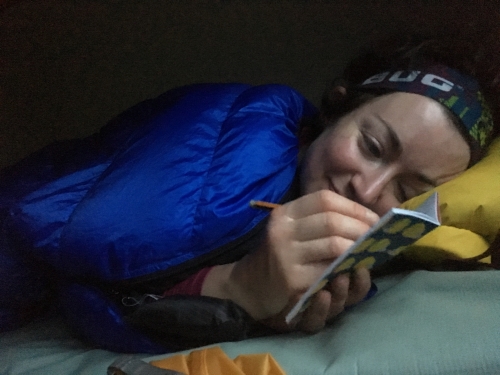Guest post: How to sleep in the NZ Backcountry by Frances Boyson

Posted 17 March 2017
Frances Boyson is hiking the Te Araroa trail in New Zealand with her Tundra Pure -5 sleeping bag.
HOW TO SLEEP IN THE NZ BACKCOUNTRY
I wish that every country had the sense to build and maintain the network of huts that New Zealand has. Across the country, at decently spaced intervals, in amazing scenic places, are 950 backcountry huts. The hut system makes it possible to have outdoors adventures while ensuring you will be protected from the elements when you need it most, and sometimes even allowing for a sense of comfort and luxury in your outdoors adventure.
When I first tramped (hiked) in NZ my companions looked in on a basic hut and said what a great hut it was. I couldn’t see the appeal of this rectangular box, with its dirty floor and old plastic-covered mattresses. But that was because I’d never arrived at a hut weary, cold and wet after eight hours crossing rivers, traversing valleys, climbing up to saddles and dropping back down again. I’d not yet experienced the relief that you feel when you see that homely shelter come into view. The happy discovery that there are enough bunks to go round. The pleasure at settling in for the night as a storm approaches. Now, when I arrive at any hut, I relive those feelings of arrival and I understand why my companions expressed such joy at something so simple.

The standard hut has bunks with mattresses, a water source (a stream or a rainwater tank) and often a fireplace or stove. It costs $5 (£2.80) per night to stay. A ‘serviced’ hut usually has firewood provided and might have a table and benches, often a good view. These cost $15 per night. Huts are first-come first-served, but if you’re in last you can always crash on the floor. All the huts have a long-drop toilet nearby.
The etiquette with huts is that you leave your muddy boots outside, make room for new arrivals, replace any firewood that you use and sweep up after you leave. You leave no rubbish: “packing out” any leftovers or food wrappers. The vast majority of people stick to these rules and that keeps the huts nice for everyone.

I’m currently walking Te Araroa, the long pathway, the trail that runs the length of NZ from North to South. I’m getting plenty of opportunity to rest in NZ’s huts. I don’t always sleep in the huts though. I can get too warm and plus I like a little time to myself after a day with a group. So I often camp outside and get the best of both worlds.

Where there are not huts, wild camping is generally permitted in the backcountry except in a few areas. The only trouble is finding a spot flat enough in NZ’s sometimes steep valleys to pitch your tent. NZ has no dangerous creatures lurking in the night to keep you awake. The mice or possums will have a go at your food if you leave it accessible so I usually bring it in the tent with me. Keas (alpine parrots) or weka (flightless birds) will play with your gear and run off with anything small and carryable. But the main area for vigilance is the sandfly, or they will disturb the peace of your tent time. The sandfly is the evil child that would be spawned if a midge and a mosquito were to breed. Extinguishing the sandflies in the tent before sleep is a nightly ritual for all NZ campers, unless you want to awaken with lasting itchy bites all over.
To keep warm on the trail nights I’m snuggled up in the Tundra Pure -5 Women’s sleeping bag. It’s the perfect bag for me in these summer and autumn months. Open, it’s cool enough for hot nights in huts; zipped all the way it’s toasty enough for camping above 1000m altitude in these seasons. Because it’s down it packs down small and light. Mine is the shorter version (180cm) but it contains the same amount of down regardless of length (400g) making it super cosy.

A night’s sleep in a hut or a tent after tramping is worth three at home. My head is clear, and there are no distractions. My muscles ache and my limbs are heavy, sinking in to the bed like they’ll never rise again. On my good days I’ll do yoga before bed to stretch my sore muscles and put me in a sleepy haze. On my even better days I’ll have a nip of whisky and hit the hay quick as a flash. After a day of hard tramping I’ll be asleep in no time.
They say the stars in NZ are to die for. But in these summer days, I’m fast asleep long before the sky puts on its lightshow.
—-
Follow Frances’ progress on her blog: https://overdueodyssey.wordpress.com/
Frances’ photos on Instagram: https://www.instagram.com/overdueodyssey/
